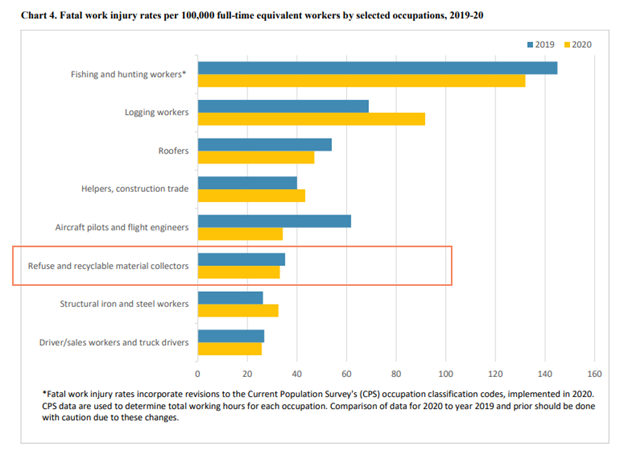Newly released data from the U.S. Bureau of Labor Statistics (BLS) shows that while solid waste fatalities declined in 2020, disproportions continue to exist overall among marginalized populations.
Solid waste continues to rank as the sixth deadliest occupation in the United States. The workplace fatality rate for collection workers fell to 33.1 in 2020 from 35.2 in 2019.
"There continues to be too many avoidable fatal incidents in and involving the solid waste industry,” said David Biderman, SWANA executive director & CEO, in a statement. “This trend has continued into 2021, with 17 fatal incidents recorded in the first two months of the year. We can and must do better.”
BLS recorded that 4,764 fatal work injuries occurred in 2020, down from 5,333 in 2019, or a 10.7 percent decrease. The overall fatal work injury rate fell to 3.4 per 100,000 full-time equivalent (FTE) workers, down from 3.5 per 100,000 FTE in 2019. This equates to one worker dying every 111 minutes from a work-related injury. The data does not include workers who died from COVID-19 or pandemic-related illnesses.

"The BLS report reminds us how important it is to use a data-driven and risk-based approach to measure and lead safety performance," the National Safety Council (NSC) stated.
Motor vehicle or transportation fatalities rank at the top, accounting for 1,778, or 37.3 percent of all work-related injuries. The National Waste & Recycling Industry Association (NWRA) recently partnered w.ith the NSC to "better understand the risks in the industry."
Despite the overall decrease in fatality rates, Hispanic or Latino workers continue to be disproportionately impacted. Fatality rates among Hispanic or Latino workers increased to 4.5 deaths in 2020, up from 4.2 deaths per 100,000 workers in 2019. This equates to 1,072 fatalities in 2020 or 22.5 percent of all fatalities, up from 1,088 fatalities, or 20.4 percent, in 2019.
The American Society of Safety Professionals (ASSP) raised concerns about the data, saying it contains "uncertainties" because "COVID-19 and work-related cancers are out of scope for this statistical report unless precipitated by an acute injury. Also, many people worked from home in 2020, meaning they were not exposed to hazards that may still exist at their workplaces upon their eventual return."
“Reacting to the latest fatality data brings unique challenges because the numbers may not paint a clear picture of the reality of 2020,” said ASSP President Brad Giles in a statement. “Any reported decrease in worker deaths is encouraging, but this data does not reflect the devastating impact of COVID-19 on many worker populations.”
Giles also referenced the rate at which Hispanic or Latino workers experience injuries and fatalities, saying, "most occupational incidents are preventable given today’s technologies and proven safety and health strategies. Employers must be more proactive in adopting voluntary national consensus standards and implementing measures such as safety and health management systems to protect workers in all industries.”
About the Author(s)
You May Also Like




